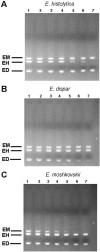A novel nested multiplex polymerase chain reaction (PCR) assay for differential detection of Entamoeba histolytica, E. moshkovskii and E. dispar DNA in stool samples
- PMID: 17524135
- PMCID: PMC1888694
- DOI: 10.1186/1471-2180-7-47
A novel nested multiplex polymerase chain reaction (PCR) assay for differential detection of Entamoeba histolytica, E. moshkovskii and E. dispar DNA in stool samples
Abstract
Background: E. histolytica, a pathogenic amoeba, is indistinguishable in its cyst and trophozoite stages from those of non-pathogenic E. moshkovskii and E. dispar by light microscopy. We have developed a nested multiplex PCR targeting a 16S-like rRNA gene for differential detection of all the three morphologically similar forms of E. histolytica, E. moshkovskii and E. dispar simultaneously in stool samples.
Results: The species specific product size for E. histolytica, E. moshkovskii and E. dispar was 439, 553 and 174 bp respectively, which was clearly different for all the three Entamoeba species. The nested multiplex PCR showed a sensitivity of 94% and specificity of 100% for the demonstration of E. histolytica, E. moshkovskii and E. dispar DNA in stool samples. The PCR was positive for E. histolytica, E. moshkovskii and E. dispar in a total of 190 out of 202 stool specimens (94% sensitive) that were positive for E. histolytica/E. dispar/E. moshkovskii by examination of stool by microscopy and/or culture. All the 35 negative control stool samples that were negative for E. histolytica/E. dispar/E. moshkovskii by microscopy and culture were also found negative by the nested multiplex PCR (100% specific). The result from the study shows that only 34.6% of the patient stool samples that were positive for E. histolytica/E. dispar/E. moshkovskii by examination of stool by microscopy and/or culture, were actually positive for pathogenic E. histolytica and the remaining majority of the stool samples were positive for non-pathogenic E. dispar or E. moshkovskii as demonstrated by the use of nested multiplex PCR.
Conclusion: The present study reports a new nested multiplex PCR strategy for species specific detection and differentiation of E. histolytica, E. dispar and E. moshkovskii DNA in stool specimens. The test is highly specific, sensitive and also rapid, providing the results within 12 hours of receiving stool specimens.
Figures



Similar articles
-
Differential detection of Entamoeba histolytica, Entamoeba dispar and Entamoeba moshkovskii in fecal samples by nested PCR in the United Arab Emirates (UAE).Acta Parasitol. 2013 Jun;58(2):185-90. doi: 10.2478/s11686-013-0128-8. Epub 2013 May 11. Acta Parasitol. 2013. PMID: 23666654
-
Comparison of multiplex-PCR and antigen detection for differential diagnosis of Entamoeba histolytica.Braz J Infect Dis. 2007 Jun;11(3):365-70. doi: 10.1590/s1413-86702007000300013. Braz J Infect Dis. 2007. PMID: 17684641
-
Diagnosis of intestinal amoebiasis by using nested polymerase chain reaction-restriction fragment length polymorphism assay.J Gastroenterol. 2007 Aug;42(8):631-40. doi: 10.1007/s00535-007-2080-6. Epub 2007 Aug 24. J Gastroenterol. 2007. PMID: 17701126
-
Laboratory diagnostic techniques for Entamoeba species.Clin Microbiol Rev. 2007 Jul;20(3):511-32, table of contents. doi: 10.1128/CMR.00004-07. Clin Microbiol Rev. 2007. PMID: 17630338 Free PMC article. Review.
-
Intestinal amebae.Clin Lab Med. 2015 Jun;35(2):393-422. doi: 10.1016/j.cll.2015.02.009. Epub 2015 Apr 4. Clin Lab Med. 2015. PMID: 26004649 Review.
Cited by
-
Entamoeba species infection in patients seeking treatment for diarrhea and abdominal discomfort in Mukuru informal settlement in Nairobi, Kenya.Food Waterborne Parasitol. 2021 Mar 29;23:e00122. doi: 10.1016/j.fawpar.2021.e00122. eCollection 2021 Jun. Food Waterborne Parasitol. 2021. PMID: 33898796 Free PMC article.
-
Laboratory diagnosis of Taenia asiatica in humans and animals.Trop Parasitol. 2013 Jul;3(2):120-4. doi: 10.4103/2229-5070.122127. Trop Parasitol. 2013. PMID: 24470995 Free PMC article.
-
Molecular testing for clinical diagnosis and epidemiological investigations of intestinal parasitic infections.Clin Microbiol Rev. 2014 Apr;27(2):371-418. doi: 10.1128/CMR.00122-13. Clin Microbiol Rev. 2014. PMID: 24696439 Free PMC article. Review.
-
Seroprevalence of Entamoeba histolytica from a tertiary care hospital, South India.Trop Parasitol. 2016 Jan-Jun;6(1):78-81. doi: 10.4103/2229-5070.175116. Trop Parasitol. 2016. PMID: 26998437 Free PMC article.
-
A Cross-Sectional Study of Entamoeba histolytica/dispar/moshkovskii Complex in Salvador, Bahia, Brazil.Biomed Res Int. 2019 Jul 24;2019:7523670. doi: 10.1155/2019/7523670. eCollection 2019. Biomed Res Int. 2019. PMID: 31428644 Free PMC article. Clinical Trial.
References
-
- World Health Organization Amoebiasis. WHO Weekly Epidemiol Rec. 1997;72:97–100.
-
- Krogstad DJ, Spencer HC, Jr, Healy GR, Gleason NN, Sexton DJ, Herron CA. Amebiasis: epidemiologic studies in the United States, 1971–1974. Ann Intern Med. 1978;88:89–97. - PubMed
MeSH terms
Substances
LinkOut - more resources
Full Text Sources
Other Literature Sources
Medical

